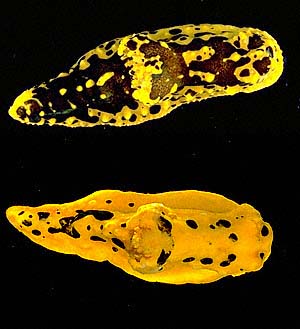
Notodoris gardineri
Eliot, 1906.
Order: NUDIBRANCHIA
Suborder: DORIDINA
Family: Aegiretidae
DISTRIBUTION
Tropical Indo-West Pacific.
PHOTO
UPPER: Heron Is., Queensland, December 1981.
LOWER: Lagoon Beach, Lord Howe Is, Coral Sea, April 1984.
PHOTOS: Bill Rudman.
The background colour is bright yellow but it is patterned with patches of black which vary greatly in size and number. The rhinophores and gills are yellow, but in juveniles the rhinophores can be black. This species is similar to N. minor in having black pigmentation, but in that species the black forms a network of lines over the body. The branched gills are situated midway along the body, partially hidden beneath three large rounded lobes. The body is rigid and toughened with tiny spicules. The rhinophores are smooth and simple. The animal can grow to approximately 10cm in length.
N. gardineri usually feeds on the calcareous sponge Pericharax heterographis (family Leucettidae), although Gosliner et al. (1996) have reported it feeding on another leucettid sponge, Leucetta primigenia. It is found on coral substrates, in depths ranging from intertidal to 20 m (commonest in depths 7-15 m).
See also Notodoris sp. 1 which is probably a juvenile form with black rhinophores.
References:
• Eliot, C.N.E. (1906) Nudibranchiata, with some remarks on the families and genera and description of a new genus, Doridomorpha. In: The fauna and geography of the Maldive and Laccadive Archipelagoes. Vol. 2(1). (Ed: Gardiner,JS) Cambridge University Press, Cambridge, 540-573. (Pl. 32)
• Gosliner, T.M. Behrens, D.W. & Williams, G.C. (1996). Coral reef animals of the Indo-Pacific. Sea Challengers, Monterey, California. 314 pp.
• Marshall, J.G. & Willan, R.C. (1999). Nudibranchs of Heron Island, Great Barrier Reef. A survey of the Opisthobranchia (Sea Slugs) of Heron and Wistari Reefs. Backhuys Publishers, Leiden, The Netherlands, 257 pp.
• Thompson, T.E. (1975). Dorid nudibranchs from eastern Australia (Gastropoda, Opisthobranchia). Journal of Zoology, London, 176: 477-517
Rudman, W.B., 2003 (July 11) Notodoris gardineri Eliot, 1906.. [In] Sea Slug Forum. Australian Museum, Sydney. Available from http://www.seaslugforum.net/find/notogard
Related messages
Black Notodoris gardineri from the Maldives
July 28, 2008
From: Marcel Tanke
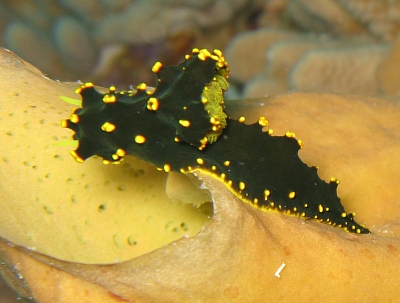
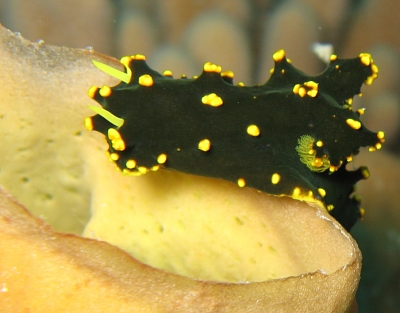
Hi Bill,
In January 2008 at North Male atoll, Maldives, we found an all black form of Notodoris gardineri. Size, say 8 cm. It was moving on a yellow sponge. At the food of the same sponge was another Notodoris gardineri, but much bigger. Say, 20 cm long and 7 cm wide (lower photo ). During the same dive we saw several more, all feeding on the same type of yellow sponge.
Locality: North Male atol, 15 meters, Maldives, Indian Ocean, 3 January 2008, reef. Length: 8 cm and 20 cm. Photographer: Marcel Tanke.
Best regards,
Marcel
marceltanke@cs.com
Tanke, M.A., 2008 (Jul 28) Black Notodoris gardineri from the Maldives. [Message in] Sea Slug Forum. Australian Museum, Sydney. Available from http://www.seaslugforum.net/find/21650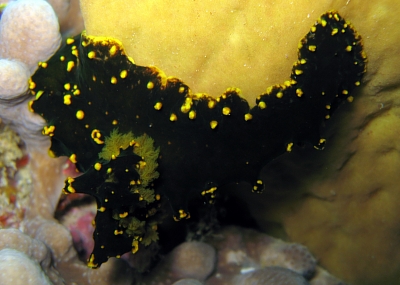
Dear Marcel,
Thanks for these photos. Nathalie Yonow (1993) reported on this very black colour form from the Maldives and gave it a varietal name N. gardineri var nigerrima. Although 'variety' names have no status in nomenclature her suggestion that all the gardineri-like animals need investigation is probably true. One thing that looks a bit strange to me is the bright yellow rhinophores in your juveniles. In the Pacific, small juveniles we identify as N. gardineri, have black rhinophores, which go through a black-tipped stage before becoming completely yellow as they grow bigger. Certainly something worth following up.
-
Yonow, N. (1994) Opisthobranchs from the Maldive Islands, including descriptions of seven new species (Mollusca: Gastropoda) . Revue française d'aquariologie, 20: 97-129. [for 1993]
Bill Rudman Rudman, W.B., 2008 (Jul 28). Comment on Black Notodoris gardineri from the Maldives by Marcel Tanke. [Message in] Sea Slug Forum. Australian Museum, Sydney. Available from http://www.seaslugforum.net/find/21650
Notodoris gardineri feeding
May 11, 2007
From: Jim Anderson
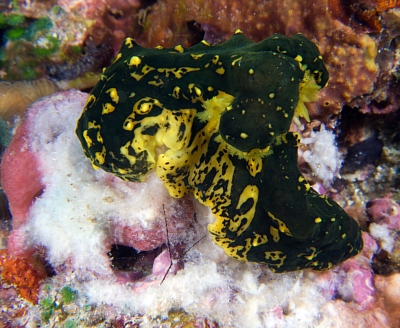
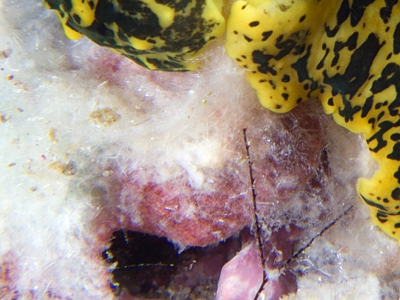
Dear Bill,
To accompany my other photos of Notodoris gardineri [message #19882] here is one of a feeding animal. It was also taken by me during a recent trip to Raja Ampat in West Papua, Indonesia
Depth 16 metres; site Api Box 2, Gam Island; typical steep coral reef; lengths 100 mm. This animal was 50 metres away from the mating pair in the previous message.
Regards,
Jim Anderson
Scottish Nudibranchs
jander4454@gmail.com
Anderson, J., 2007 (May 11) Notodoris gardineri feeding. [Message in] Sea Slug Forum. Australian Museum, Sydney. Available from http://www.seaslugforum.net/find/19898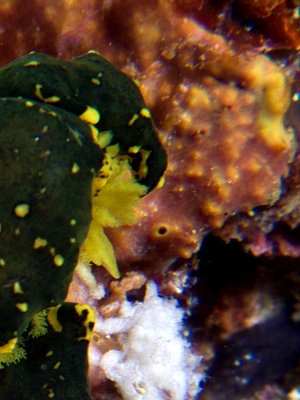
Dear Jim,
Thanks for this photo of Notodoris gardineri making is usualy mess when it is feeding. I am pretty sure the sponge is its usual food, the calcareous sponge Pericharax heterographis. In the close-up alongside I show a bit of the brownish part of the colony behind the slug. The sponge colony can be different colours in different parts an I think the pinkish mass you can see in the other close-up is also part of the sponge colony.
The white 'cotton-wool' looking stuff all around the animal are the sponges calcareous spicules which have been discarded by the slug as it eats the sponge. Most slugs when feeding take bites of the sponge and swallow it spiclues and all, sorting out the spicules in the stomach and discarding them in faecal pellets. Notodoris though seems to spit the spicules out as it is eating and sometimes you can see a great pile of this white 'cotton-wool' alongside the head. I would be interested to know if others have observed this.
Best wishes,
Bill Rudman
Notodoris gardineri from West Papua
May 11, 2007
From: Jim Anderson
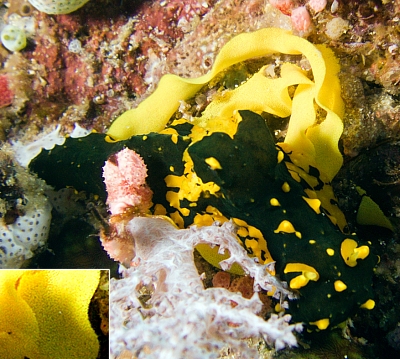
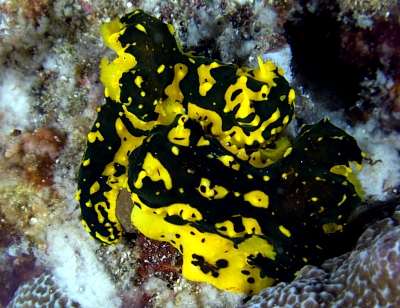
Dear Bill,
I know you like images of them doing things so here is a set of Notodoris gardineri.
They were all taken by me during a recent trip to Raja Ampat in West Papua, Indonesia and some details follow
Upper: Depth 15 metres; site Chicken Reef, Kri Island; typical steep coral reef; length 100 mm.
Lower: Depth 20 metres; site Api Box 2, Gam Island; typical steep coral reef; lengths 100 and 100 mm.
Regards,
Jim Anderson
Scottish Nudibranchs
jander4454@gmail.com
Anderson, J., 2007 (May 11) Notodoris gardineri from West Papua. [Message in] Sea Slug Forum. Australian Museum, Sydney. Available from http://www.seaslugforum.net/find/19882Dear Jim,
I do indeed like photo of them 'doing things' and your set had so much going on that I moved the feeding photo to a separate message [#19898] so I had room to add some close-ups.
It's nice to get a good photo of the yellow egg ribbon, which as we can see in the inset, contains many very small egs indicating that the larvae will spend sometime living and feeding in the plankton. Your lower phot of the mating pair is interesting for the white mess round the animals. As I discuss in your feeding message, this white 'cotton-wool' are masses of calcareous spicules from their sponge food. It suggests that one or both of these animals had a prenuptial feast
Best wishes,
Bill Rudman
Notodoris gardineri? from Okinawa
March 19, 2004
From: Kunihiro Takahashi
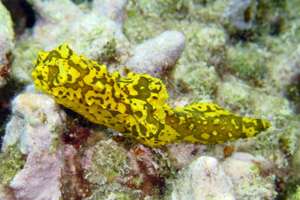
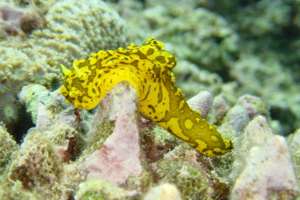
Dear Dr.Rudman,
I found this at Okinawa. I think it is Notodoris gardineri.. Could you identify this please?
Date: 14 March,2004
Location: Cape Maeda,Okinawa, Japan
Depth: 5m
Length: 40mm
W/Temp: 20C degree
Photo by Aya Takahashi
Best Regards,
Kunihiro Takahashi
manta9216@tontonme.ne.jp
Takahashi, K., 2004 (Mar 19) Notodoris gardineri? from Okinawa. [Message in] Sea Slug Forum. Australian Museum, Sydney. Available from http://www.seaslugforum.net/find/12477Dear Kunihiro,
Yes this is N. gardineri. Some species have much more black on them than others
Best wishes
Bill Rudman
Notodoris gardineri from Lord Howe Island
January 22, 2003
From: W.B. Rudman
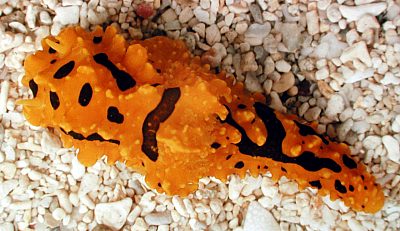
Here is a photo record from Ian Hutton of Notodoris gardineri from Lord Howe Island.
Bill Rudman
Rudman, W.B., 2003 (Jan 22) Notodoris gardineri from Lord Howe Island. [Message in] Sea Slug Forum. Australian Museum, Sydney. Available from http://www.seaslugforum.net/find/8976Notodoris gardineri - juvenile
January 3, 2003
From: Bruce Potter
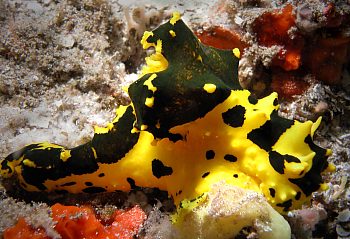
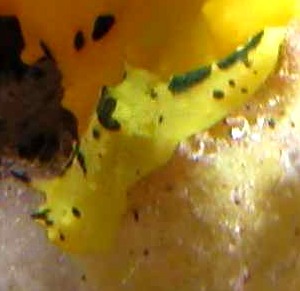
Dear Bill,
There was a discussion a few weeks ago about the possibility that juvenile Notodoris might have dark rhinophores, which became pure yellow as they got older.
Yesterday I found this adult Notodoris gardineri not far from two other adults, and then noticed the tiny juvenile centre foreground. The juvenile was about 14mm. long, while the adult was about 90mm.
I noticed that the juvenile has black tipped rhinophores. I went back and had another look today, and the juvenile is still with the adult. Not far away another adult was laying eggs. This was at about 16 meters near a boat wreck on coral and rubble, just outside of Honiara, Solomon Islands, 22 December 2002.
Regards
Bruce Potter
bruce.potter@adventist.org.sb
Potter, B., 2003 (Jan 3) Notodoris gardineri - juvenile. [Message in] Sea Slug Forum. Australian Museum, Sydney. Available from http://www.seaslugforum.net/find/8741Thanks Bruce,
It certainly looks as though the three yellow species have black-rhinophored juveniles. Unfortunately close proximity of adults and juveniles does not mean they are a family group, it just means they all like feeding on the same sponge. What we need now is a few more intermediate stages showing the rhinophores, or best of all a captive animal which could be seen changing colour
Best wishes,
Bill Rudman
Colour change in Notodoris gardineri
December 5, 2002
From: Julie Marshall
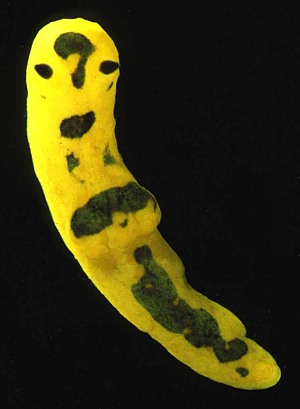
Dear Bill,
Following your comments and Richard Willan’s message about the change in the colouration of the rhinophores of Notodoris gardineri from black to yellow I am attaching a photo of the animal we called Notodoris sp. 1 in Marshall and Willan, (1999). It was 14mm in size and found at a depth of 12m at Heron Island on the sponge, Pericharax heteroraphis.
Best wishes,
Julie Marshall
juliemarshall@netspace.net.au
Marshall, J., 2002 (Dec 5) Colour change in Notodoris gardineri. [Message in] Sea Slug Forum. Australian Museum, Sydney. Available from http://www.seaslugforum.net/find/8555Thanks Julie,
I think the Forum is particularly good at pulling together little bits of information like this to make an interesting whole.
Best wishes,
Bill Rudman
Juvenile Notodoris gardineri
November 25, 2002
From: Bill Rudman
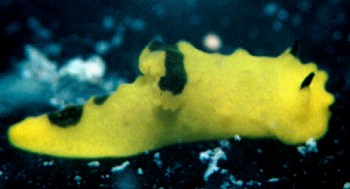
Following Marina's photos of Notodoris minor with black-tipped rhinophores, here are some photos of juvenile N. gardineri with black rhinophores.
These three photos were taken by Geoff Avern, over 3 years, at Heron Island, Queensland, Australia. They are of juvenile Notodoris which were found on their food sponge Pericharax. I assume that they are all Notodoris gardineri.
Upper right: 8mm long alive, 25 May 1981, AM C128157
Lower Left: 5mm long preserved, 6 Sept 1982, AM C135360.
Lower Right: 7m, 10mm long alive, 20 Jan. 1983, AM C137409. Photos: G. Avern.
It would appear from these photos, and other observations I have made, that N. gardineri starts life with a plain yellow body, and black rhinophores, then gradually develops a black colour pattern on its body, and at the same time loses the black pigmentation on the rhinophores. Marina's photos suggest N. minor may do the same.
Best wishes,
Bill Rudman
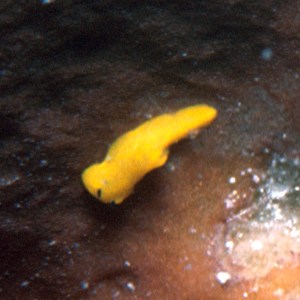
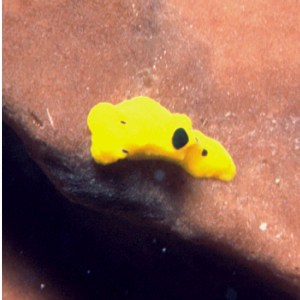
Notodoris gardineri from Sulawesi
May 7, 2002
From: Mary Jane Adams
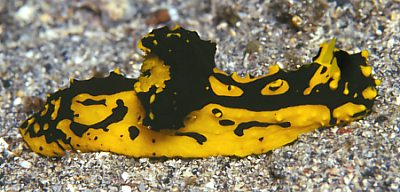
Hi Bill,
This one was a bit of a surprise. I photographed this Notodoris gardineri crawling over a sand slope in Lembeh Strait, Sulawesi, Indonesia, April 11, 2002. It was about 12 cm long. Divesite: Aw Shucks
Mary Jane
divepng@yahoo.com
Adams, M J., 2002 (May 7) Notodoris gardineri from Sulawesi. [Message in] Sea Slug Forum. Australian Museum, Sydney. Available from http://www.seaslugforum.net/find/6883Thanks Mary Jane,
Bill Rudman
Re: Brittle stars and nudibranchs
February 12, 2000
From: Gordon Hendler
Dear Mary Jane,
Bob Bolland alerted me to your question about brittle stars in "Sea Slug Forum." I checked the site, and admired both your photographs and your curiosity.
I can't answer your question with precision, but I can relate a couple of points that might be of interest. There are a fair number of brittle star species that live in association with sponges and various kinds of corals. In some cases the relationship is very specific, and in other cases the
brittle stars are not particular about their hosts. There is evidence that some associations could be mutually beneficial (commensal). There are many fewer instances reported of brittle stars that "hitch a ride" on mobile species, but some brittle stars are known to ride from place to place on sea urchins and even on jellyfish.
I cannot identify the brittle stars that you photographed on Notodoris, but I can tell you that brittle star phoresy on nudibranchs has not been reported in the echinoderm literature. It would be well worthwhile to photograph and any similar instances in the future, make detailed notes on the behavior of the animals, and collect specimens of the brittle stars that occur on the nudibranchs and on the sponges that the nudibranchs crawl across. Small, delicate brittle stars such as the ones you photographed are best preserved in alcohol.
Many brittle stars have planktonic larvae, which provide an effective dispersal stage early in the life cycle. Other species, some of which associate with corals, have benthic, crawl-away young. We are just beginning to learn about the varied and interesting ways that post-larval brittle stars migrate. Along those lines, you may be on to something interesting. I'd be grateful to hear what you find in the future.
Sincerely,
Gordon Hendler
Curator of Echinoderms
Natural History Museum of Los Angeles County.
Hendler@nhm.org
Hendler. G., 2000 (Feb 12) Re: Brittle stars and nudibranchs. [Message in] Sea Slug Forum. Australian Museum, Sydney. Available from http://www.seaslugforum.net/find/1886Notodoris gardineri from Papua New Guinea
February 11, 2000
From: Mary Jane Adams
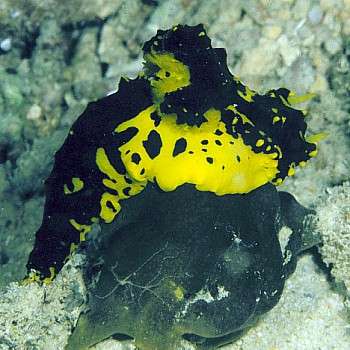
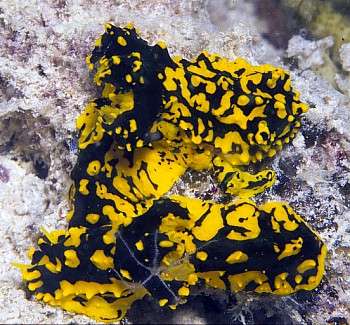
Dear Bill,
Although Notodoris minor is common in PNG, especially Milne Bay, I have only seen Notodoris gardineri twice. Both sightings were on night dives on Middle Reef near New Hanover Island in northern Papua New Guinea. This is a silty, coral rubble reef.
The UPPER picture of N. gardineri feeding on a sponge, was taken at 7 meters on Nov. 28, 1996. There was a second one about a meter away. The LOWER photo of a group of three was taken at about the same depth on Sept. 9, l998. There were two others near by. Several things have always puzzled me about this "family portrait." Do you think the brittle star is purposefully hitchhiking, or just there incidentally? Could the tiny nudibranch in the middle be mating with the full sized one? Do nudibranchs have to be full sized to mate? N. gardineri looks very much like a melanistic variety of N. minor. What are the anatomical differences that make them separate species?
Thanks!
Mary Jane Adams
mjadams@earthlink.net
Adams, M.J., 2000 (Feb 11) Notodoris gardineri from Papua New Guinea. [Message in] Sea Slug Forum. Australian Museum, Sydney. Available from http://www.seaslugforum.net/find/1873Dear Mary Jane,
The Notodoris species pages are certainly filling out! Let's look at some of your questions.
•The brittle star question. This certainly raises an interesting point. As your upper feeding photo shows there are species of little brittle stars which are often found on sponges. I don't know if anyone has shown they exclusively live on sponges or whether they are just more easily seen on sponges. If they do live exclusively on sponges then I suppose hitching a ride on a sponge feeder would be a good way to move from sponge to sponge.
•Mating size in nudibranchs. Opisthobranchs are all hermaphrodite which means they have both a male and female reproductive system. Often the male system develops early in the growth of the animal and some species, which we call protandrous, become functional males at a much smaller size than they become functional females. In others both systems are fully mature and working at half the species full adult size. So it is possible that the small Notodoris is a functional male. The only way to be sure would be to have given them a nudge and seen if they were attached to each other.
•Anatomical differences in Notodoris.
Certainly some colour forms of N. gardineri look like very black forms of
Best wishes,
Bill Rudman.
Notodoris from Sunshine Coast
July 27, 1998
From: Wayne Ellis
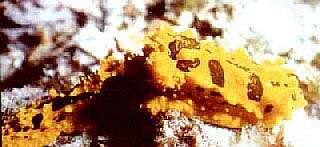
Hi Bill,
Here is another of Steve Grail's photos. It was taken off Mooloolaba, Sunshine Coast, southern Queensland, in 10-20m, between 1996 and 1998.
Regards,
Wayne Ellis
glaskin@ozemail.com.au
Ellis, W., 1998 (Jul 27) Notodoris from Sunshine Coast. [Message in] Sea Slug Forum. Australian Museum, Sydney. Available from http://www.seaslugforum.net/find/158Wayne,
Notodoris gardineri feeds on a calcareous sponge called Pericharax. It can often be found nestled in a large pit or cavity in the dull brownish yellow sponge which it has produced while eating away at the sponge tissue. Sometimes a pile of white calcareous spicules will be piled up alongside, but I do not know if they are spat out while the sponge is being eaten or defecated after digestion. There is another very similarly looking species, Notodoris minor which is also yellow but has a pattern of black lines rather then patches. Whether these two are distinct species or just part of a range of colour variation is unknown. A third species, Notodoris citrina is plain yellow. It is slightly different in shape and feeds on a different species of sponge. At present, species of Notodoris, which can grow to 12cm or more in length, are considered to be closely related to the genus Aegires, with species usually less than 5mm long. They have similarities, but it is possible that these similarities are related to their similar life styles rather than there phylogenetic history. Species of Aegires also feed on calcareous sponges... Bill Rudman.
